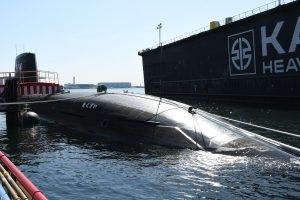The Japan Maritime Self-Defense Force (JMSDF) has commissioned the second of its Taigei-class diesel-electric attack submarines (SSK), which feature better underwater endurance than its older boats.
Named JS Hakugei (with pennant number SS 514), the new boat was inducted into the Escort Division 1 of Escort Flotilla 1, which is homeported at the Kure naval base in Hiroshima prefecture, shortly after being handed over by shipbuilder Kawasaki Heavy Industries (KHI) in a ceremony held at its facility in Kobe City in western Japan’s Hyogo prefecture on March 20.
Hakugei means “white whale” in Japanese. The Taigei class submarines all incorporate “Gei” (whale) into their names, following the “Shio” (tide) and “Ryu” (dragon) series seen in previous JMSDF submarines. “Taigei” itself means “big whale.”
According to the JMSDF, the new submarine has a crew complement of about 70, an overall length of 84 meters, a beam of 9.1 m, a draught of 10.4 m, and a standard displacement of about 3,000 tonnes. It is slightly larger than the well-known previous Soryu-class SSKs, which are 84 m long, 9.1 m wide, 10.3 m depth, and have a standard displacement of 2,950 tonnes.
The new submarine, which cost about 71.7 billion yen ($548 million) to build, is powered by a diesel-electric engine generating 6,000 hp.
Japan’s security environment is becoming ever more fraught. Looking at submarines along, China and Russia are increasing their nuclear submarine forces, and North Korea is also aiming to possess nuclear submarines. In such a situation, Japan – which does not have nuclear submarines, with their excellent cruising and diving capabilities – faces a major challenge in improving the capabilities of conventional submarines.
As parts of such efforts, the JMSDF began installing lithium-ion batteries in place of the conventional lead-acid batteries starting from the 11th and 12th Soryu-class submarines. The latest Taigei-class submarines were designed to be equipped with lithium-ion batteries from the beginning.
Lithium-ion batteries have more than twice as much energy density compared to lead-acid batteries. According to Ridzwan Rahmat, principal defense analyst at military publisher Janes, this enables submarines to remain underwater longer versus lead acid ones. The greater underwater endurance makes the vessels harder to detect and will expand the range of operations that can be undertaken by the JMSDF.
Besides conventional submarine warfare, the vessels may also be deployed closer to enemy shores to conduct reconnaissance missions or land special forces personnel.
GS Yuasa, a Kyoto-based developer and manufacturer of battery systems, provided the lithium-ion batteries for those new submarines. So far Japan is the only country known to have fitted lithium-ion batteries into SSKs. South Korea is expected to be the next country to do so with the second batch of KSS-III (also known as Dosan Ahn Chang-ho)-class submarines.
The first Taigei-class submarine, named Taigei (with pennant number SS 513), was commissioned in March 2022. Meanwhile, the third Taigei-class submarine, named Jingei (with pennant number SS 515), was launched by Mitsubishi Heavy Industries (MHI) in October 2022 and is expected to enter service in March 2024. Jingei means “speedy whale.”
Japan’s Ministry of Defense has allocated funds for the construction of four more submarines of the class – SS 516, SS 517, SS 518, and SS 519– with KHI building the first and third, and MHI the second and fourth of those four boats.
Most recently, on December 23, 2022, the Japanese defense ministry was allocated 80.8 billion yen for fiscal year 2023 starting April to build the seventh boat of the class.
Japan’s Defense Buildup Program, approved by the government in mid-December last year, states, “To gain underwater supremacy, MSDF will develop a submarine (SS) equipped with Vertical Launching System (VLS) with the aim of acquiring stand-off missiles carrying submarines.”
To realize this, it is expected that new high-powered diesel engines and related equipment will be installed from the fourth Taigei-class ship. It is increasingly important to secure additional power supply capacity in order for the Taigei-class to carry the VLS.
In addition, it is inevitable that Japan’s new submarine hulls will become larger from now on, as a result of mounting not only the VLS, but also carrying next-generation high-powered sonar and various underwater unmanned vehicles (UUVs).

































